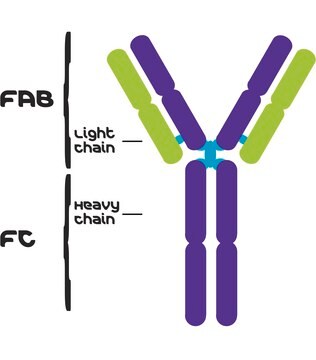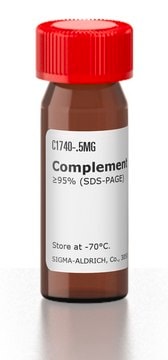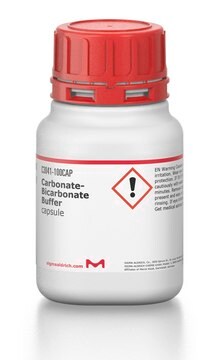I9010
Anti-Human IgG (Fab specific) antibody produced in goat
whole antiserum
Sign Into View Organizational & Contract Pricing
All Photos(1)
About This Item
Recommended Products
biological source
goat
Quality Level
conjugate
unconjugated
antibody form
whole antiserum
antibody product type
secondary antibodies
clone
polyclonal
contains
15 mM sodium azide
technique(s)
indirect ELISA: 1:30,000
quantitative precipitin assay: 4.0 mg/mL
shipped in
dry ice
storage temp.
−20°C
target post-translational modification
unmodified
Looking for similar products? Visit Product Comparison Guide
General description
Immunoglobulin G (IgG) belongs to the immunoglobulin family and is a widely expressed serum antibody. Immunoglobulins have two heavy chains and two light chains connected by a disulfide bond. It is a glycoprotein. IgG is usually found as a monomer. IgG is further subdivided into four classes namely, IgG1, IgG2, IgG3, and IgG4. About 70 percent of the total immunoglobulin consists of IgG.
Specificity
Reactivity is observed versus purified human IgA, IgM, Bence Jones Kappa and Bence Jones Lambda myeloma proteins. No reactivity is observed versus Fc fragment of human IgG.
Application
Anti-Human IgG (Fab specific) antibody produced in goat has been used in immunological assays. It has also been used in cellulose substrates as immobilized anti-hIgG to detect human immunoglobulin G (hIgG) from fluid matrices.
Anti-Human IgG (Fab specific) antibody produced in goat was used in capture ELISA at a dilution of 1:10,000.
Biochem/physiol Actions
IgG antibody subtype is the most abundant of serum immunoglobulins of the immune system. It is secreted by B cells and is found in blood and extracellular fluids and provides protection from infections caused by bacteria, fungi and viruses. Maternal IgG is transferred to fetus through the placenta that is vital for immune defense of the neonate against infections.
Physical form
Supplied as a liquid containing 15 mM sodium azide as a preservative.
Preparation Note
delipidized
Storage and Stability
For continuous use, store at 2-8 °C for up to one month. For extended storage, the solution may be frozen in working aliquots. Repeated freezing and thawing is not recommended. Storage in "frost-free" freezers not recommended. If slight turbidity occurs upon prolonged storage, clarify the solution by centrifugation before use.
Disclaimer
Unless otherwise stated in our catalog or other company documentation accompanying the product(s), our products are intended for research use only and are not to be used for any other purpose, which includes but is not limited to, unauthorized commercial uses, in vitro diagnostic uses, ex vivo or in vivo therapeutic uses or any type of consumption or application to humans or animals.
Not finding the right product?
Try our Product Selector Tool.
Storage Class Code
10 - Combustible liquids
WGK
WGK 2
Flash Point(F)
Not applicable
Flash Point(C)
Not applicable
Personal Protective Equipment
dust mask type N95 (US), Eyeshields, Gloves
Choose from one of the most recent versions:
Already Own This Product?
Find documentation for the products that you have recently purchased in the Document Library.
S Küpcü et al.
Journal of immunological methods, 196(1), 73-84 (1996-09-13)
In the present study, cup-shaped 1-3 microns large cell wall fragments from Thermoanaerobacter thermohydrosulfuricus L111-69 covered with a hexagonal S-layer lattice composed of glycoprotein subunits were shown to act as a matrix for the immobilization of human IgG. After cross-linking
Jane A Potter et al.
Journal of virology, 86(23), 12923-12932 (2012-09-21)
The E2 envelope glycoprotein of hepatitis C virus (HCV) binds to the host entry factor CD81 and is the principal target for neutralizing antibodies (NAbs). Most NAbs recognize hypervariable region 1 on E2, which undergoes frequent mutation, thereby allowing the
Wei Wang et al.
Journal of pharmaceutical sciences, 96(1), 1-26 (2006-09-26)
The number of therapeutic monoclonal antibody in development has increased tremendously over the last several years and this trend continues. At present there are more than 23 approved antibodies on the US market and an estimated 200 or more are
Vanessa M Cowton et al.
NPJ vaccines, 6(1), 7-7 (2021-01-10)
HCV vaccine development is stymied by the high genetic diversity of the virus and the variability of the envelope glycoproteins. One strategy to overcome this is to identify conserved, functionally important regions-such as the epitopes of broadly neutralizing antibodies (bNAbs)-and
S Hashira et al.
Pediatrics international : official journal of the Japan Pediatric Society, 42(4), 337-342 (2000-09-15)
Maternal immunoglobulin G (IgG), transferred across the placenta to the fetus during intrauterine life, is an important component of the neonatal immunological defence mechanisms against infection. There is controversy with respect to differences in placental transfer of the different IgG
Our team of scientists has experience in all areas of research including Life Science, Material Science, Chemical Synthesis, Chromatography, Analytical and many others.
Contact Technical Service








